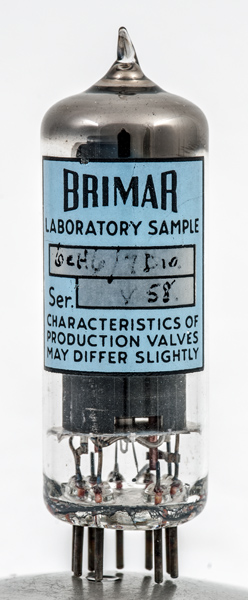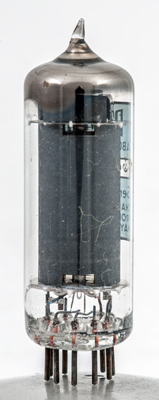|
6CH6Sensibly equivalent¶ to:See also:
|
|
|

|
This exhibit is a pre-production laboratory sample of the 6CH6. Type 6CH6 is a video output amplifier used in professional applications for driving TV or radar signals down (fairly) long cables. We did not think that it was much used in domestic sets, however, Wojtek M writes that it was used in the 1955 STC Tymatic clock radio made in Australia.Thanks to PA3FVQ for some additional information on the 6CH6. This valve was used as the audio output valve in the Rees-Mace receiver AKA the Pye marine receiver AP100339 that was built in the 1950s and extensively used by British and Dutch navies. The question remains as to why the 6CH6 was the valve of choice for this receiver when so many purpose designed audio valves could have been selected.Sources specifically list it as a video amplifier. Note the high value of gm, necessary in order to obtain reasonable gain and power output with wideband signals, and for correct matching of video into coax cable. TV studio equipment racks used to be full of 6CH6s.Thanks to John Fielding (ZS5JF) for following information. The 6CH6/EL821/CV2127 was used by KW Electronics as the PA driver valve in the KW2000 series of SSB transceivers. Later versions of the KW2000 used the more popular 6BW6, however like the 12BY7 series all these valves were originally designed for television video amplifier duty.The valve is pin compatible with the 6BW6 but they have different uses.
The outer carbonised cylinder is the anode.The thin glass tube envelope is 20 mm in diameter, and excluding the B9A base pins, is 59 mm tall.References: Data-sheet, 1040, 3002, PA3FVQ & John Fielding. Type 6CH6 was first introduced in 1952. See also 1952 adverts. |
Pin Connections
| 1 | 2 | 3 | 4 | 5 | 6 | 7 | 8 | 9 |  ic | g1 | k | h | h | nc | a | g2 | g3 |
|
|
Absolute Maximum Operating Conditions¶
| Vh | Ah | Va | Vs | Vg | mAa | mAs | ra | gm | Pout | D | 
| 6.3 | 0.75 | 250 | 250 | -4.5 | 40 | 6 | 50,000 | 11 | 3W | 8.5% |
|
Updated January 08, 2022.
|
|